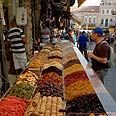
Jerusalem: 5 free things for visitors to do
Typically known for religious sites, Jerusalem proves to offer much more: Market, Mormon University, neighborhoods and views
But Jerusalem's impossible beauty has broad appeal beyond religion or history. For residents and tourists, secular or pious, city slickers or nature lovers, there is always an unexplored alleyway, corner or vista to show the city as you've never seen it before. And many of these sites are free.
Sacred sites
Jerusalem's most famous holy sites are inside the Old City walls, past a maze of small alleys, bustling marketplaces and wide squares.The Temple Mount, also known as Haram al-Sharif (in Arabic, the Noble Sanctuary), is a well-known but controversial landmark. The hilltop compound is the holiest site in Judaism, believed to be where Abraham almost sacrificed his son Isaac, and where the First and Second Temples were built. The Temple Mount includes the Western Wall, the last remnant of the Second Temple built by King Herod in the first century. Jews gather here to pray and leave notes between the stones.

Temple Mount (Photo: Ron Peled)
For Muslims, the compound is home to the Al-Aqsa Mosque and gold-capped Dome of the Rock, one of Jerusalem's most recognizable symbols. This is Islam's third-holiest place, after the cities of Mecca and Medina in Saudi Arabia. According to Islamic tradition, this is where Prophet Muhammad ascended to heaven on his Night Journey.
A short walk away is the Church of the Holy Sepulcher, the holiest of Christian sites. It is said to be located where Christ was crucified (the Golgotha) and buried. The site, built by Roman Emperor Constantine in 325, was destroyed in the 11th century and restored by Crusaders a century later. Despite large crowds, it offers plenty of corners for solitary prayer and meditation.
The Mahane Yehua Market
With its pushy crowds, spiced smells, deafening shouts and melting pot of people, the Mahane Yehuda market is a metaphor for Jerusalem.The 19th-century "shuk" or market is located in a central area of West Jerusalem and in recent years has become a place to shop, hang out, sip coffee and eat delicious world food.
Get lost in countless food stalls featuring colorful produce, sweet halva (sesame paste cakes), fish mongers, international wines and cheese. The market's recent gentrification has attracted a mix of pottery stores, coffee shops and small restaurants from Middle Eastern to Ethiopian to Italian cuisine. Bars open when the stalls close. On Monday nights, one bar offers dance music, letting you wrap your "shuk" day with tired, happy feet.
The Mormon University
Located on Mount Scopus below the Hebrew University, Brigham Young University's center for study in Jerusalem _ which belongs to the Utah-based Mormon Church, gives free tours of its impressive building and concert hall, including stunning views of the holy city. Each of the 1987 edifice's 117 tall arches offers a sweeping vista of the biblical Kidron Valley and Old City landmarks. Guided tours include a short video and live 10-minute classical music performance on a pipe organ, said to be the largest in the Middle East. The 3,165 pipes produce beautiful cathedral-like sounds.Pass through Byzantine mosaics as you head downstairs to the eighth floor terrace. Here, amid rose bushes, are several scale models of Jerusalem through the centuries, while present-day Jerusalem lies before you. The Mormon University also offers free classical music on Sundays and jazz concerts on selected Thursdays. Seats go fast; reserve ahead by emailing concerts(at)jc.byu.ac.il.
Neighborhoods and views
The Mishkenot Sha'ananim neighborhood overlooking the Old City is an elegant maze of light pink and beige stone houses interrupted by staircases, green spaces and flowers. Its alleys recall neatly kept Italian and French Medieval towns, but luscious, bright bougainvilleas add a Middle Eastern feel.Mishkenot Sha'ananim (Photo: Itzik Shwiki)
Built in 1860, Mishkenot Sha'ananim was the first Jewish neighborhood outside the Old City walls. The restored Montefiore Windmill opens up to dramatic views of the Old City, making this a favorite spot for taking pictures.
Farther east, a walk from the American Colony Hotel to the Old City's Damascus Gate takes you through a lively area of Arab Jerusalem. Built as a house for a pasha and his four wives, the hotel became the lodging of choice for Westerners in the early 1900s. It remains a favorite of journalists and diplomats, with an impressive courtyard and garden.
Damascus Gate
From the hotel, walk toward the Old City through Saladin Street, the heart of Arab East Jerusalem. Browse through bookshops and clothing stores or stop at the French Institute's pink stone building before reaching the Damascus Gate. Called Bab el-Amoud in Arabic, this may be the most beautiful of Jerusalem's entrances to the Old City, built in the Ottoman era by Suleiman the Magnificent.
Damascus Gate offers a glimpse of Palestinian life, with women wearing traditional embroidered dresses shopping for groceries or selling vegetables along the entrance road. The scent of sage, cardamom and cumin fill the air around brightly colored stalls selling food, clothes and perfumes. The road forks after you pass through the gate; go left for the Austrian Hospice, a guesthouse and cultural center in Austro-Hungarian style, and head upstairs for an up-close view of Old City rooftops. The hospice coffee shop is famous for Eastern European cakes and strudels.











